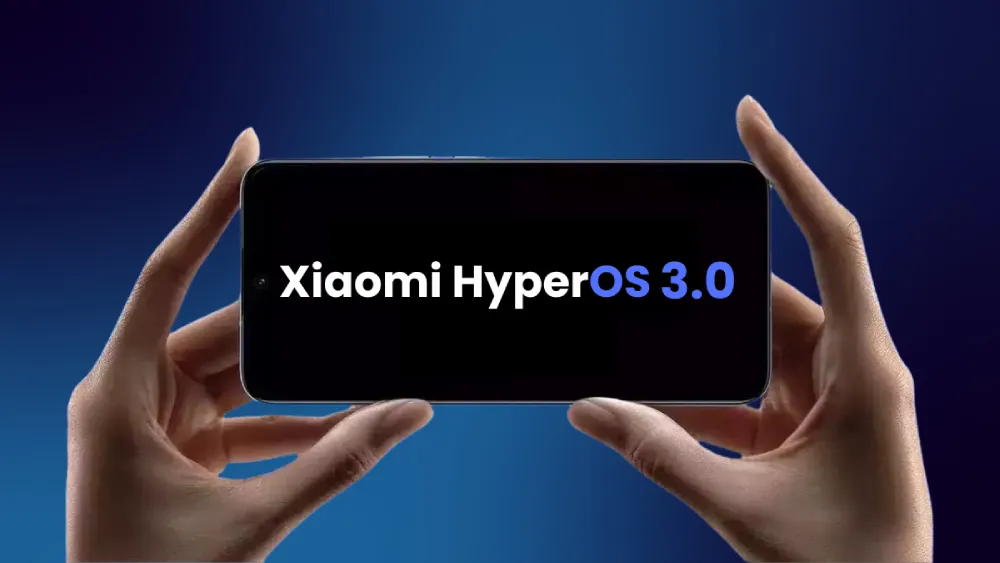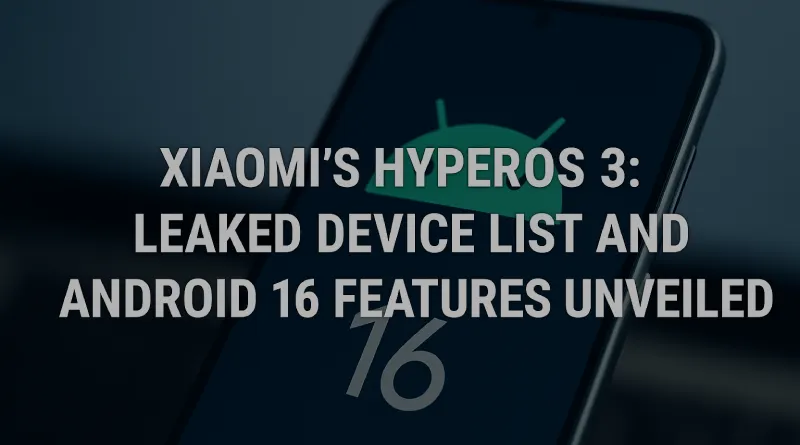Xiaomi’s HyperOS 3: Leaked Device List and Android 16 Features Unveiled
HyperOS 3 will be the third version launched by Xiaomi; this one is building up quite the hype with its list of supported devices and other features expected to change the user experience of millions of people, as it is based on Android 16. It should receive an update in September or October 2025 with the Xiaomi 16 series and is expected to bring a performance boost and AI-fueled customization, as well as an updated interface. Since Xiaomi is keeping silent, the leaks provided by some sources, such as Technetbooks or Cashify, make people excited and frustrated by what device will be first to roll out and what innovations to expect, out of pleasure or disappointment, respectively.
Eligible Devices: Who’s Getting HyperOS 3?
The leaked list highlights a broad range of Xiaomi, Redmi, and POCO devices poised for HyperOS 3, focusing on models from 2022 onward due to hardware compatibility with Android 16. Key devices include
- Xiaomi Series: Xiaomi 15, 15 Pro, 15 Ultra, 14, 14 Pro, 14 Ultra, 14T, 13, 13 Pro, 13 Lite, 13T, 12, 12 Pro, 12S, 12S Ultra, CIVI 3, and CIVI 4 Pro.
- Redmi Note Series: Note 14, 14 Pro, 14 Pro+, 13, 13 Pro, 13 Pro+, 13R, 12 4G, 12 4G NFC, 12S, 12T Pro, 12 Turbo.
- Redmi Number & A Series: Redmi 12, 13, 13C, 14C, 14C 5G, A3 Pro, A4 5G, A5.
- Redmi K & Turbo Series: K80, K80 Pro, K70, K70 Pro, K70 Ultra, K60, K60 Pro, K50 Ultra, Turbo 3, Turbo 4.
- POCO Series: F7, F7 Pro, F7 Ultra, F6, F6 Pro, F5, F5 Pro, X7, X7 Pro, X6 5G, X6 Pro 5G, M7 Pro 5G, M6 5G/4G, M6 Pro 5G/4G, C75, C65.
- Foldables & Tablets: MIX Fold 4, 3, 2, MIX Flip, Flip 2, Pad 7, 7 Pro, 6 Pro, 6S Pro, Redmi Pad Pro, Pro 5G, SE, SE 8.7.
Among the lower-end models, it is slightly disappointing that older models, such as the Xiaomi 11 series or Redmi Note 12 5G, might be left behind by the two-year major update policy on mid-range models, which prompts user dissatisfaction on forums such as X, where users complain about the lack of HyperOS 2 releases in models such as the POCO X6 Pro and Redmi Note 13 Pro+.

Expected Features: A Leap Forward with Android 16
It has been constructed on Android 16, and HyperOS 3 presents itself as smooth and AI-based. It has key features, which, on the basis of leaks, include:
- Liquid Glass UI: A modern, laid-back interface using transparent windows, blurred effects, and fluid animation usable on the latest Snapdragon 8 Gen 3 and above devices is available, offering a gorgeous look and feel to the 300 million-plus smartphone owners of India.
- Intelligent Notification Bar: Merged notifications, priority calling, and iOS-like toggles simplify operations and meet user needs in terms of clarity in metropolitan markets such as Mumbai.
- AI-Powered Camera: Low-light improvements and better portrait images as well as video stabilization to meet the social media needs of the 1.4 billion Indian users of social media who value camera quality.
- Game Turbo Mode: It is optimized to play games such as PUBG, and Game Turbo helps reduce lag and battery, which will benefit the 509 million of the mobile gamer populace in India, as per Statista.
- Dynamic Island: Such a feature is provided on a few current models, such as the Xiaomi 15 series; interactive pop-ups can be displayed during music playback and during calls, contributing to the increasing possibility of multitasking.
- Custom Lock Screen: New fonts, animations, and smart widgets such as weather updates keep the experience personalized, which the youthful, tech-centric India will enjoy.
- Ecosystem Integration: Robust interconnection with Xiaomi wearables and smart home gadgets and solutions, which will attract the expanding IoT industry in India that, according to NASSCOM, will total over $1.9 billion by 2025.
Rollout Timeline and Regional Context
Xiaomi is to gradually introduce it with flagships such as the Xiaomi 15 series as of July 2025, the Redmi Note 14 and POCO F7 series as of September-October, and mass models as of November. China will be the first to receive the update, followed in October or November by India and Europe, during the festive season in India when phone sales climb 20 percent, according to IDC. But there is also an issue of regional delays, as evident in HyperOS 2, in which Indian users of devices such as the POCO X6 Pro have complained of lags, and only 30 percent of applicable devices will be upgraded by January 2025, according to user feedback on X.
How to Prepare for HyperOS 3
In order to check eligibility, download the Memos Enhancer program available on the Google Play Store, and your device scans to identify compatibility with HyperOS 3 and Android 16. In order to update, go to Settings > About Phone > System Updates, and have at least 5-10 GB of free storage and a stable Wi-Fi connection. Early access is available to the beta program by application through the Xiaomi Mi Community application, but beware of bugs, so save all data. In the case of ineligible devices, third-party apps can emulate HyperOS capabilities, but official updates should be implemented where security is an issue.
Unique Insights and Challenges
This has also seen the removal of popular models such as the Redmi Note 12 Pro 5G and Xiaomi 13T, which has instigated backlash with users on X complaining that Xiaomi’s update policy is unfair to newer 5G models over budget 4G models. This is an indication of how Xiaomi is interested in focusing its strategy to cater to the price-conscious market segment in India, where 60 percent of the sales are currently captured by 4G devices, according to Counterpoint. Nonetheless, the integration of the ecosystem and emphasis on artificial intelligence makes HyperOS 3 a rival to Samsung One UI 6, particularly for gamers and content creators in cities such as Bangalore. To prevent problems such as HyperOS 2, which users report flickering on Redmi Note 13 Pro, clear the cache and submit bugs through Mi Community.
HyperOS 3 will transform the ecosystem of Xiaomi, but proper delivery and extension to more devices will surely help to sustain user confidence in markets such as India, where 70 million Xiaomi devices are currently operating, according to company statistics.
Disclaimer
The information presented in this blog is derived from publicly available sources for general use, including any cited references. While we strive to mention credible sources whenever possible, Web Techneeq – Web Development Agency in Mumbai does not guarantee the accuracy of the information provided in any way. This article is intended solely for general informational purposes. It should be understood that it does not constitute legal advice and does not aim to serve as such. If any individual(s) make decisions based on the information in this article without verifying the facts, we explicitly reject any liability that may arise as a result. We recommend that readers seek separate guidance regarding any specific information provided here.

